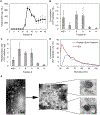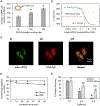Milk exosomes with enhanced mucus penetrability for oral delivery of siRNA
- PMID: 33367332
- PMCID: PMC8205963
- DOI: 10.1039/d0bm01497d
Milk exosomes with enhanced mucus penetrability for oral delivery of siRNA
Abstract
Bovine milk-derived exosomes have recently emerged as a promising nano-vehicle for the encapsulation and delivery of macromolecular biotherapeutics. Here we engineer high purity bovine milk exosomes (mExo) with modular surface tunability for oral delivery of small interfering RNA (siRNA). We utilize a low-cost enrichment method combining casein chelation with differential ultracentrifugation followed by size exclusion chromatography, yielding mExo of high concentration and purity. Using in vitro models, we demonstrate that negatively charged hydrophobic mExos can penetrate multiple biological barriers to oral drug delivery. A hydrophilic polyethylene glycol (PEG) coating was introduced on the mExo surface via passive, stable hydrophobic insertion of a conjugated lipid tail, which significantly reduced mExo degradation in acidic gastric environment and enhanced their permeability through mucin by over 3× compared to unmodified mExo. Both mExo and PEG-mExo exhibited high uptake by intestinal epithelial cells and mediated functional intracellular delivery of siRNA, thereby suppressing the expression of the target green fluorescence protein (GFP) gene by up to 70%. We also show that cationic chemical transfection is significantly more efficient in loading siRNA into mExo than electroporation. The simplicity of isolating high purity mExo in high concentrations and equipping them with tunable surface properties, demonstrated here, paves way for the development of mExo as an effective, scalable platform technology for oral drug delivery of siRNA.
Conflict of interest statement
Conflicts of Interest
There are no conflicts to declare.
Figures








Similar articles
-
Milk exosomes anchored with hydrophilic and zwitterionic motifs enhance mucus permeability for applications in oral gene delivery.Biomater Sci. 2024 Jan 30;12(3):634-649. doi: 10.1039/d3bm01089a. Biomater Sci. 2024. PMID: 38047368 Free PMC article.
-
Post-insertion technique to introduce targeting moieties in milk exosomes for targeted drug delivery.Biomater Res. 2023 Nov 29;27(1):124. doi: 10.1186/s40824-023-00456-w. Biomater Res. 2023. PMID: 38031117 Free PMC article.
-
Milk exosome-infused fibrous matrix for treatment of acute wound.J Control Release. 2024 Dec;376:79-93. doi: 10.1016/j.jconrel.2024.09.053. Epub 2024 Oct 9. J Control Release. 2024. PMID: 39366455
-
Milk Exosomes: Next-Generation Agents for Delivery of Anticancer Drugs and Therapeutic Nucleic Acids.Int J Mol Sci. 2023 Jun 15;24(12):10194. doi: 10.3390/ijms241210194. Int J Mol Sci. 2023. PMID: 37373342 Free PMC article. Review.
-
Milk exosomes: A biogenic nanocarrier for small molecules and macromolecules to combat cancer.Am J Reprod Immunol. 2021 Feb;85(2):e13349. doi: 10.1111/aji.13349. Epub 2020 Oct 6. Am J Reprod Immunol. 2021. PMID: 32966664 Review.
Cited by
-
Exosomes as Natural Nanocarriers for RNA-Based Therapy and Prophylaxis.Nanomaterials (Basel). 2022 Feb 2;12(3):524. doi: 10.3390/nano12030524. Nanomaterials (Basel). 2022. PMID: 35159869 Free PMC article. Review.
-
Evaluating the oral delivery of GalNAc-conjugated siRNAs in rodents and non-human primates.Nucleic Acids Res. 2024 Jun 10;52(10):5423-5437. doi: 10.1093/nar/gkae350. Nucleic Acids Res. 2024. PMID: 38742636 Free PMC article.
-
Milk-derived extracellular vesicles and gut health.NPJ Sci Food. 2025 Jan 30;9(1):12. doi: 10.1038/s41538-025-00375-1. NPJ Sci Food. 2025. PMID: 39885215 Free PMC article. Review.
-
Cationic-motif-modified exosomes for mRNA delivery to retinal photoreceptors.J Mater Chem B. 2024 Jul 31;12(30):7384-7400. doi: 10.1039/d4tb00849a. J Mater Chem B. 2024. PMID: 38946491 Free PMC article.
-
Milk-derived exosomes as a promising vehicle for oral delivery of hydrophilic biomacromolecule drugs.Asian J Pharm Sci. 2023 Mar;18(2):100797. doi: 10.1016/j.ajps.2023.100797. Epub 2023 Mar 1. Asian J Pharm Sci. 2023. PMID: 37035132 Free PMC article.
References
-
- Odom EBP, K.B.; Odom DC, Clinical Research, 2016, 8.
-
- Shepard J, Ward W, Milstone A, Carlson T, Frederick J, Hadhazy E and Perl T, JAMA Surg, 2013, 148, 907–914. - PubMed
MeSH terms
Substances
Grants and funding
LinkOut - more resources
Full Text Sources
Other Literature Sources

